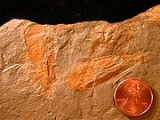
Hyolitha
Encyclopedia

Animal
Animals are a major group of multicellular, eukaryotic organisms of the kingdom Animalia or Metazoa. Their body plan eventually becomes fixed as they develop, although some undergo a process of metamorphosis later on in their life. Most animals are motile, meaning they can move spontaneously and...
s with small conical
Conical surface
In geometry, a conical surface is the unbounded surface formed by the union of all the straight lines that pass through a fixed point — the apex or vertex — and any point of some fixed space curve — the directrix — that does not contain the apex...
shells known from the Palaeozoic Era.
Shell morphology
The calcareousCalcium carbonate
Calcium carbonate is a chemical compound with the formula CaCO3. It is a common substance found in rocks in all parts of the world, and is the main component of shells of marine organisms, snails, coal balls, pearls, and eggshells. Calcium carbonate is the active ingredient in agricultural lime,...
shells have a cover (operculum
Operculum (gastropod)
The operculum, meaning little lid, is a corneous or calcareous anatomical structure which exists in many groups of sea snails and freshwater snails, and also in a few groups of land snails...
) and two curved supports known as helens. Most are one to four centimeters in length and are triangular or elliptical in cross section. Some species have rings or stripes.
Taxonomy & ecology
Because hyoliths are extinct and do not obviously resemble any extant group, it is unclear which living group they are most closely related to. They may be molluscs; authors who suggest that they deserve their own phylum do not comment on the position of this phylum in the tree of life. Fossil traces showing a twisted, looped, intestine bear some resemblance to the gut of sipunculaSipuncula
The Sipuncula or Sipunculida is a group containing 144-320 species of bilaterally symmetrical, unsegmented marine worms...
n worms.
Despite the fact that hyolithid shells are common as fossil
Fossil
Fossils are the preserved remains or traces of animals , plants, and other organisms from the remote past...
s, little is known about their ancestry, internal structures, and life mode. They were probably benthic (bottom-dwellers).
Fossil record
The first hyolith fossils appeared about in the Purella antiqua Zone of the Nemakit-Daldynian Stage of SiberiaSiberia
Siberia is an extensive region constituting almost all of Northern Asia. Comprising the central and eastern portion of the Russian Federation, it was part of the Soviet Union from its beginning, as its predecessor states, the Tsardom of Russia and the Russian Empire, conquered it during the 16th...
and in its analogue the Paragloborilus subglobosus–Purella squamulosa Zone of the Meishucunian Stage of China
China
Chinese civilization may refer to:* China for more general discussion of the country.* Chinese culture* Greater China, the transnational community of ethnic Chinese.* History of China* Sinosphere, the area historically affected by Chinese culture...
. Hyolith abundance and diversity attain a maximum in the Cambrian
Cambrian
The Cambrian is the first geological period of the Paleozoic Era, lasting from Mya ; it is succeeded by the Ordovician. Its subdivisions, and indeed its base, are somewhat in flux. The period was established by Adam Sedgwick, who named it after Cambria, the Latin name for Wales, where Britain's...
, followed by a progressive decline up to their Permian extinction.

